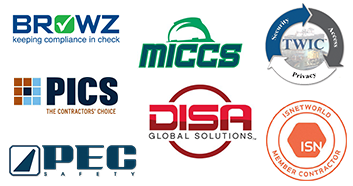FRP Doesn’t Need Cathodic Protection
Fiberglass Reinforced Polymers (FRP) do not need cathodic protection. Cathodic protection is a technique, common in many industries, used to control the corrosion of a surface of metal. It’s important when discussing FRP to distinguish between different types of corrosion resistance properties- in the case of cathodic protection- we are talking about electrochemical corrosion or the electrochemical oxidation of metals.
Cathodic Protection
Cathode protection is a technique used to control the corrosion of a metal surface. This is accomplished by making the surface or some part of the surface the cathode of an electrochemical cell. The simplest way to achieve cathodic protection is to attach an anode or “sacrificial metal” to the metal that is to be preserved. It is frequently implemented when passive galvanic cathodic protection is not sufficient. Cathodic protection is not always effective and in some instances can be costly. On the other hand, FRP do not undergo electrochemical corrosion and are regarded as a cost-effective material solution with low maintenance costs.
Composite Technology
A composite is a material system made up of two or more material components. For a fiber reinforced polymer (FRP) composite, the primary ingredients are the resin matrix and reinforcing fiber, which is typically fiberglass in various forms. The intrinsic properties of a finished composite and the attributes of cured resins provide resistance to corrosive attacks from chemicals, solvents, hydrocarbons, and moisture.
Electrochemical Corrosion Resistance
Fiberglass Reinforced Polymers- The Superior Choice
There are many types of corrosion, pitting, crevice, weld decay, microbial, chemical and high temperature, to name a few. Electrochemical corrosion or rust becomes apparent when iron oxides and salts are produced of the original metal.
Corrosion, in this context will degrade or diminish the physical properties of the metal making it an inferior material choice when compared to FRP of an equal size. In addition, FRP may be formulated and manufactured to have chemical corrosion resistance. Furthermore, FRP do not demonstrate pitting, corrosion, weld decay, or crevice oxidation as many metals do.
FRP Applications- Case in Point
In the petroleum industry, underground steel piping requires cathodic protection systems and will be subjected to inherent periodic testing requirements. Therefore, a cost effective alternative to underground steel piping and cathodic protection is FRP pipe.
There are a plethora of circumstances, in different industries, where replacing steel pipe, tanks, basins, and ventilation systems with FRP products could greatly reduce costs associated with monitoring, maintenance and reconstruction.
Applications of Cathodic Protection
Cathodic protection is used in many industries as a measure to mitigate or control the effects of corrosion on metal surfaces. A common application is in galvanized steel, in which a sacrificial coating of zinc on steel parts protects them from rust. Other common applications are; steel water or fuel pipelines and storage tanks such as home water heaters, steel pier piles, ship and boat hulls, offshore oil platforms and onshore oil well casings and metal reinforcement bars in concrete buildings and structures. FRP may be used as a corrosion resistant material solution in many of these applications.






